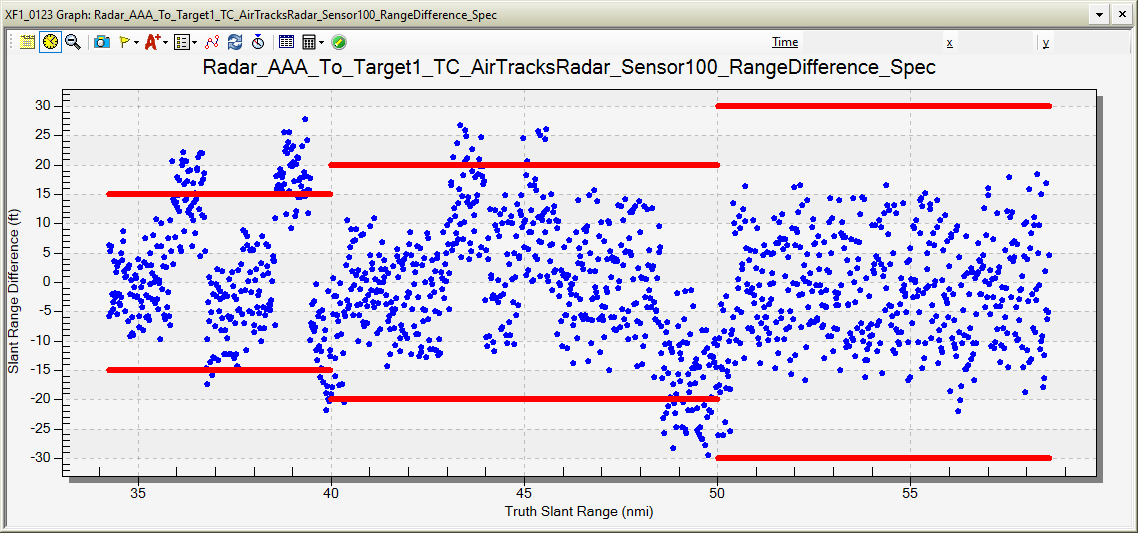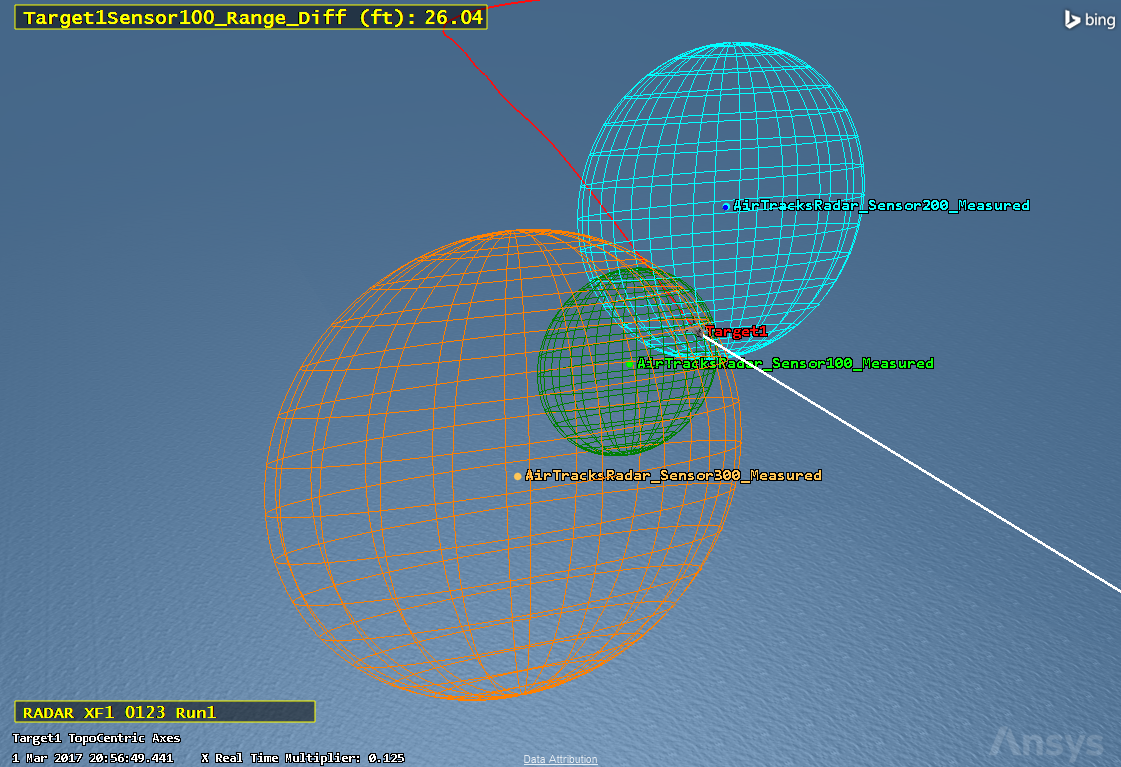STK Enterprise
You can obtain the necessary licenses for this tutorial by contacting AGI Support at support@agi.com or 1-800-924-7244.
Capabilities covered
- Test and Evaluation Tool Kit (TETK)
- STK Pro
Preparing the track comparison workflow
- Open the Custom Workflows window (
 ) in the Test and Evaluation Tool Kit toolbar.
) in the Test and Evaluation Tool Kit toolbar. - Click Tracks from the workflow dropdown selector.
- Click the AirTracksRadar_Sensor100 track and change the Dynamic Settings to Current.
- Click .
- Promote the AirTracksRadar_Sensor100 to an aircraft object to do analysis by clicking the Promote track to aircraft button (
 ), or by right-clicking it and choosing the same option.
), or by right-clicking it and choosing the same option. - You will now see an aircraft object in the Object Browser called AirTracksRadar_Sensor100_Measured.
- Change the color to lime green by double-clicking the color swatch on the left of the object.
Comparing the Air Tracks data for Run 1
- In the Custom Workflows window, select the TrackComparison workflow from the drop-down and create a new (
 ) comparison.
) comparison. - Set the Track to AirTracksRadar_Sensor100.
- The Name defaults to TC_AirTracksRadar_Sensor100.
- Verify the Ownship is set to XF1_0123.
- In the Truth Object section, click the plus button (
 ) and choose Target1.
) and choose Target1. - The Measured Object section defaults to AirTracksRadar_Sensor100_Measured.
- Under Calculation Settings in the Data Reference Frame field, click the frame button (
 ) and choose XF1_0123_NorthWestUp.
) and choose XF1_0123_NorthWestUp. - In the Distance Error Reference Frame field, choose the same frame that was used for the Data Reference Frame.
- In the Time Interval section, click the time components button (
 ) and choose RADAR_XF1_0123_Run1.
) and choose RADAR_XF1_0123_Run1. - In the Data Time Step Source section, select Measured.
- Select the Include Covariance and Error Ellipse checkbox.
- Click . This may take a moment.
- After calculations are complete, select the TC_AirTracksRadar_Sensor100 track comparison and click the Track Comparison Results Calculator (
 ) button.
) button. - Create a data display (
 ) by clicking the button in the left panel of the window and choose the TC_AirTracksRadar_Sensor100_RangeDifference. Note that this parameter could be added to a new data display in the Flight Analysis Tool using the method you’ve already learned. This is a quicker way to make the data display if you’re already in the Results Calculator.
) by clicking the button in the left panel of the window and choose the TC_AirTracksRadar_Sensor100_RangeDifference. Note that this parameter could be added to a new data display in the Flight Analysis Tool using the method you’ve already learned. This is a quicker way to make the data display if you’re already in the Results Calculator. - Close the Results Calculator .
- In the Flight Analysis Tool, double-click the TC_AirTracksRadar_Sensor100_Results under Data Display to open its properties.
- Change the display text for the selected element to Target1Sensor100_Range_Diff.
- Change the units to ft.
- If desired, adjust the window location and/or X and Y translation values to not overlap existing displays you have added to the 3D window.
- Click .
Configuring the spec sets
Spec sets in the Ansys Test and Evaluation Tool Kit (TETK)™ capability are used to set desired measure of performance (MOPs) values over a span of values for a particular evaluation parametric. A common set when analyzing tracking data is to look at the slant range difference (MOP) over the span of slant range values between the ownship and the truth object (evaluation parametric). To further explain these two parameters, the slant range difference is calculated by taking the range between the ownship and the measured object position and then subtracting the range between the ownship and the truth object position. So the value is positive when the measured position is further than the truth position, relative to the ownship position. The truth slant range is simply the range value between the ownship and the truth object position.
- In the Custom Workflows window, select the Track Comparison workflow and click the Configure spec sets button (
 ).
). - Add (
 ) a new spec set. Define the following fields as follows:
) a new spec set. Define the following fields as follows: - Add (
 ) four specs and set them as follows:
) four specs and set them as follows: - Click .
- Close the Mange Spec Sets window.
- Select TC_AirTracksRadar_Sensor100.
- Open the Comparison results calculator (
 ). Here you can see the evaluation parametric minimums and maximums, as well as the Measures of Performance (MOP) statistics.
). Here you can see the evaluation parametric minimums and maximums, as well as the Measures of Performance (MOP) statistics. - Change the units for the Truth Slant Range to nmi.
- Set the Filter From field to 30.
- Set the Filter To field to 40.
- Click the refresh button (
 ) in the upper left of the window. At the bottom of the page, you will see 321 of 1341 (23%) of the measured track data fall within these filters. You can also observe the statistics for those 23% of the tracks.
) in the upper left of the window. At the bottom of the page, you will see 321 of 1341 (23%) of the measured track data fall within these filters. You can also observe the statistics for those 23% of the tracks. - Click the Create Results Graph button (
 ).
). - Change the Slant Range Difference units to ft.
- Change the Truth Slant Range units to nmi.
- Ensure the Include Spec Set check box in enabled.
- Click .
- Close the graph.
- Click the Create Results Table button (
 ).
). - Leave all defaults and click . This gives you statistics for each interval of specs you set earlier.
- Close the Statistics Table and the Track Results Calculator.
| Field | Value |
|---|---|
| Subsystem | Radar AAA |
| Evaluation Parametric | Truth Slant Range, nmi |
| MOP | Slant Range Difference, ft |
| Type | MinMax |
| Evaluation Parametric From | Evaluation Parametric To | MOP Min | MOP Max |
|---|---|---|---|
| 30 | 40 | -15 | 15 |
| 40 | 50 | -20 | 20 |
| 50 | 75 | -30 | 30 |
| 75 | 125 | -40 | 40 |
The red lines represent the specs you set earlier: ± 20, ± 25, ± 30, and ± 35. In the first two range buckets, you can see there are a number of points that fall outside of the spec.

You can see the Percent out of Spec row shows that from 30 to 40 nmi truth slant range , just over 22% of the captured data is out of spec.
Showing the covariance ellipses
- In the Custom Workflows window, select Tracks, then select AirTracksRadar_Sensor100.
- Change the Dynamic Setting to Currentif needed.
- Under Track Graphics tab, select the Covariance sub-tab.
- Note that the Show Position Covariance check box is already enabled. Since the track mapping has covariance data mapped, this ellipse automatically turns on when the track is promoted.
- Ensure the Use Comparison Colors check box is enabled.
- Click .
- In the 3D Graphics window, zoom to Target1 and you will see the ellipse drawn around the measured track.
- Toggle on AirTracksRadar_Sensor200.
- With AirTracksRadar_Sensor200 selected, change the Dynamic Setting to Current. Click .
- To show the covariance ellipsoid, Promote track to aircraft (
 ).
). - Repeat Steps 8-10 for AirTracksRadar_Sensor300.
- For both Sensor 200 and Sensor 300, go to the Covariance tab and select the Show Position Covariance check box.
- Change the default colors so the ellipsoids can be differentiated.
- Click .
- Animate through the scenario and watch the covariance ellipsoids change as the measured tracks change.
- Save your scenario.
Similar to the ship tracks, the ellipse will be green if the truth Target1 object falls within the ellipse, and it will turn red if the truth object falls outside the ellipse.

BONUS: Create a TrackComparison for Sensor 200 and 300 to determine the CovarianceOut times for these two sensors.